The answer to, “What is the best budget long-range rifle scope?” is definitely up for debate, along with other related topics. Because of this, let’s discuss why I think Vortex’s Strike Eagle 5-25×56 is the clear winner of its division.
NOTE: For the purpose of this article, I’m referring to sub $900 MSRP optics as “budget.”

What’s So Great About The Strike Eagle?
Before we compare it to other optics, I want to outline the features of the Strike Eagle (for short). This optic comes with locking tactical style turrets, RevStop Zero System (“zero stop”), an illuminated first focal plane reticle (FFP), side parallax adjustment from 15 yards-infinite, sunshade, billet magnification throw lever, a huge 34mm main tube that allows for a ton of internal adjustment, generous eye-relief, and a large 5-25x magnification range to cover the most distinguishing features. Typically, when you spend $799 on a rifle scope, you hope that it comes with tactical-style turrets, and maybe an FFP reticle. Forget a solid zero-stop system, illumination, 34mm tube… you get the idea.
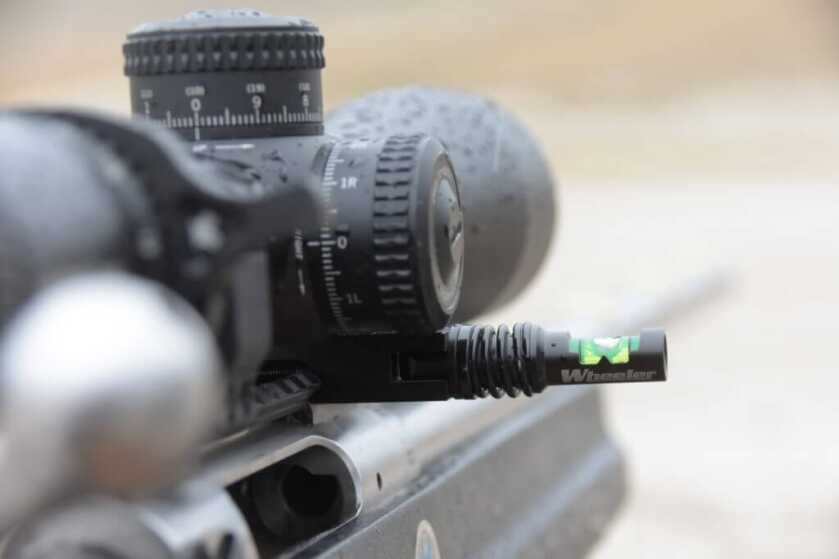
My Favorite Features: In-Depth
It’s a simple addition, but the included magnification ring throw lever is a nice touch to the full package that the Strike Eagle is. When making adjustments in magnification, the extra leverage that comes from a lever makes these adjustments easier, faster, and more controllable. I found that I am able to adjust my magnification without imparting torque on my rifle, otherwise pulling it off level.
Some will never notice the importance of an extremely short parallax adjustment, but let me tell you why this feature makes the Strike Eagle stand out: Many people shooting precision 22lr matches will need parallax settings in the 10-15 yard range. As this sport grows increasingly popular, it becomes important for scope manufacturers to identify this need and cater to this crowd. With the low 5x magnification, wide parallax range, and high 25x magnification, this optic can be used on 10-100 yard 22lr shots on tiny targets as well as 100-1,000 yard shots and beyond for those real hot-rod rifles.

Speaking of extremely long shots, the 15 mils (~50 MOA) of elevation that you can get out of the Strike Eagle while the RevStop Zero System is set is enough to bring you out to the transonic range of your typical 308 Winchester (1,100 yards-ish). This means that you can get exactly double this range with a 6.5 Creedmoor’s flatter trajectory…. yes, that is a joke because I couldn’t keep myself from taking shots. We’ll talk some more about the turrets and how they work in a bit.
The First Focal Plane reticle is a great feature that the Strike Eagle 5-25×56 boasts. In this configuration, the reticle appears to grow and shrink as the magnification is raised and lowered respectively. The effect that this has is accurate subtensions across the magnification range. Or, in other words, 1 Mil on the reticle accurately represents 1 Mil on 5x as well as 25x and all magnifications in-between. An FFP reticle is more difficult to manufacture, and typically adds a few hundred dollars (at least) to the cost of any scope model. This leads me to the reticle offerings; Vortex’s EBR-7C is a healthy balance of measurement options and easy to use/clutter-free. This reticle comes in both MOA and MIL options, and both are excellent.
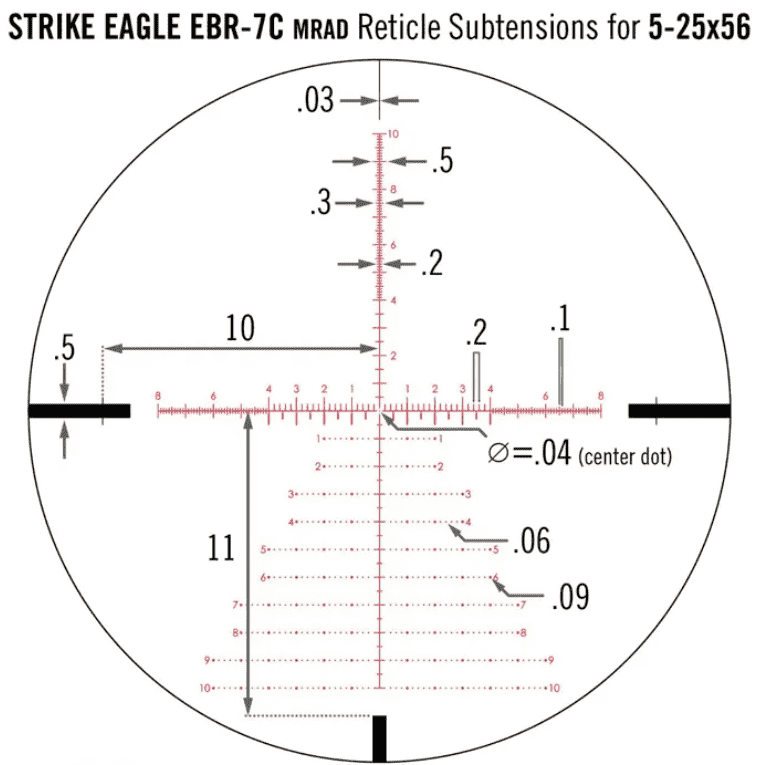
The Turrets
This subject also falls under the “My Favorite Features” section, but I wish to discuss the turrets on this scope separately. Being one of the most important interfaces between a long-range shooter and his rifle system, the turrets are extremely important and must give a “high quality” feel, or else the whole optic will seem cheap. The elevation and windage turret on the Strike Eagle both scream this, making me wonder how vortex is getting away with selling the optic for $799. When rotating either turret, they click in stiff, positive intervals with a crisp sound. Also, both turrets lock in a lift, push manner. To me, a hunter, this is paramount. When packing a rifle and deploying it to engage a target quickly, it is of utmost importance that your turrets did not “wander” while rubbing up against other gear in your pack.
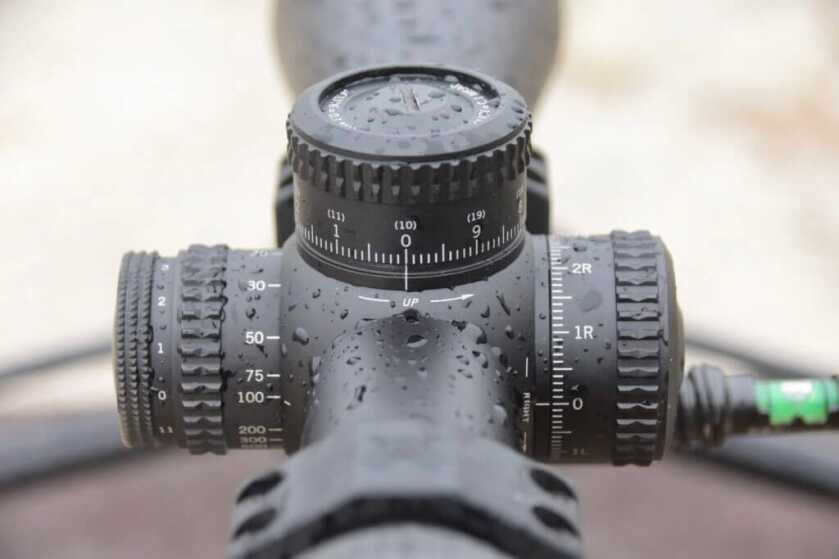
With the RevStop Zero System, the turrets have all the features of a $2,000 optic minus a revolution indicator. This zero stop system is extremely easy to set, only requiring the removal of the turret, placement of the RevStop disk, rotation of the disk clockwise till it stops and then the re-installation of the turret. After completing these steps, you get 1/2 Mil or 1 MOA (depending on which model you have) adjustment below zero, at which, you are met with a hard stop and a loud click.
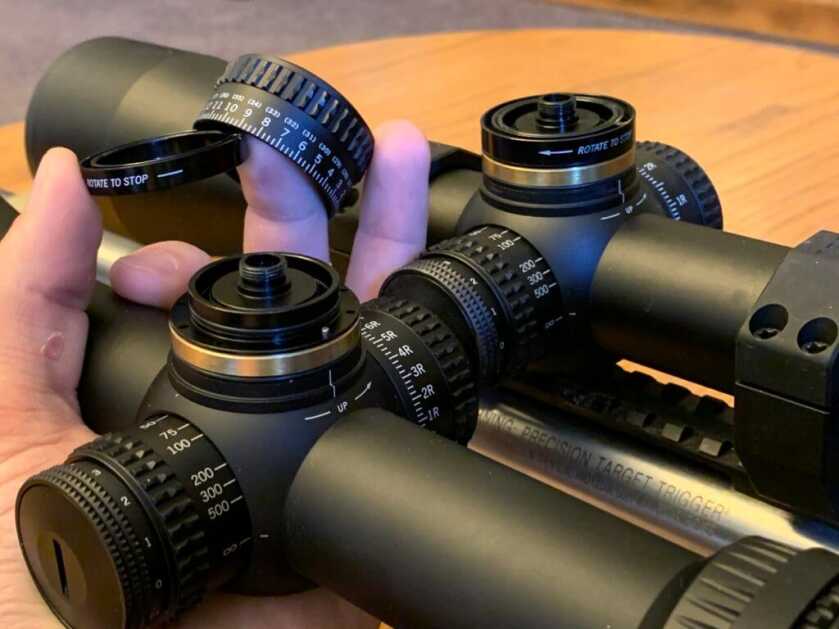
To point out a minor detail that I greatly appreciate, the Strike Eagle lineup does not need Allen wrenches for removal or adjustment of the turrets. This may be an underappreciated detail by many, but as someone who is always adjusting multiple optics in the field simultaneously, I love this. The turrets on the Strike Eagle are removed and adjusted with a simple coin-slot style cut that can be engaged with a variety of common items. Here’s a scenario: you are headed to the range, maybe you were in a hurry to run out the door before the sun got up and put you in a 100-degree sweat-filled afternoon. Oops! you forgot your Allen wrench set. Now, you can’t sight in your *namebrand* optic, but at least you still have a box of cartridges that you can use the rim of for adjusting your Vortex Strike Eagle. The day is not wasted from a turn-around trip back home.
Performance In The Field
When dealing with a more affordable optic; clarity, definition, sight picture, and the color is always a concern. The Strike Eagle scores extremely well in all of these areas. I compared this optic side-by-side to a $2,800 optic and the difference was (dare I say it) almost unnoticeable. I say almost because the higher dollar optic did appear to be slightly crisper around the edges of objects, and color appeared a hue warmer than reality through the Strike Eagle. Without the literal side x side comparison, I’m not sure that I could cast any stones at the Strike Eagle because it really is excellent. Other things that I noted after further inspection; the strike eagle scored perfectly in edge-to-edge clarity and the reticle is efficient, clean, and easy to use/see across the whole power range.
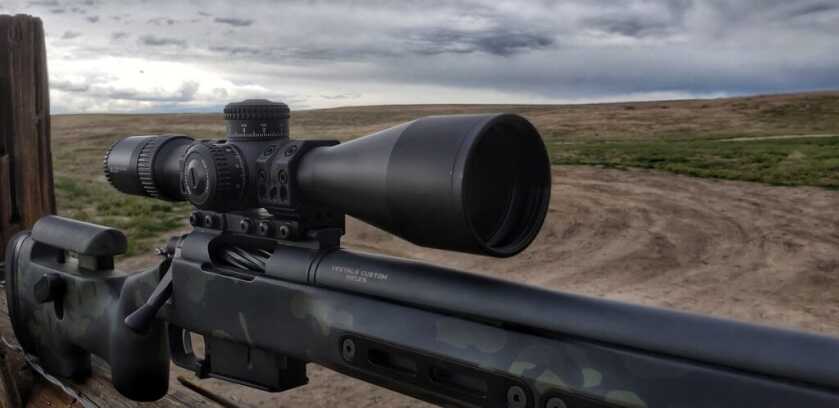
After putting some rounds down range at a distance, I continued to enjoy the turrets on the Strike Eagle. They are extremely tactile as you ratchet them around to your next adjustment. I found it easy to count clicks without staring at the turret in order to adjust the scope. My single gripe is that there is no rotation indicator, meaning if you had dialed two revolutions on the turret, you either had to remember where you were at or test this by returning to zero and then dialing back up.
The illuminated reticle is something that I rarely utilize in real-world activities, but you have this option nonetheless. The Strike Eagle has 11 different intensities with one off position. This red illumination on the max setting is not “daylight bright” as I know some of you will wonder. Though, I could see over a shaded target in the middle of the day. For my own curiosity, I’d like to hear in the comments how important an illuminated reticle is for you, and how you utilize it.
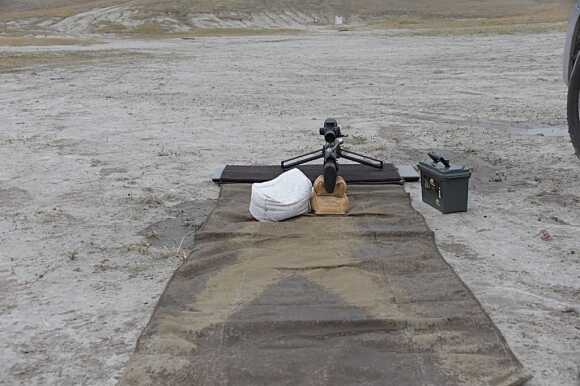
Turret Tracking Accuracy
As with all of my rifle optics tests, I checked the most important aspect of the Strike Eagle 5-25×56 (in my opinion) using a tall target test in order to determine the scope’s tracking accuracy. The first step in this test is to mount the optic on the gun using a bubble level and plumb bob. This has to correlate to a rifle mounted bubble level which will be used in the field to level the optic. Next, I take a gridded target (with 1-inch squares in my case). This helps me level the target while in the field for the test. It is important to use a precise rifle for this test to minimize any kind of error. For this purpose, I used my Savage target rifle with criterion barrel chambered in 308 Winchester. For ammunition, I used some hand loads pushing 185 grain Berger juggernaut OTM tactical projectiles, Lapua brass, and Varget rifle powder.
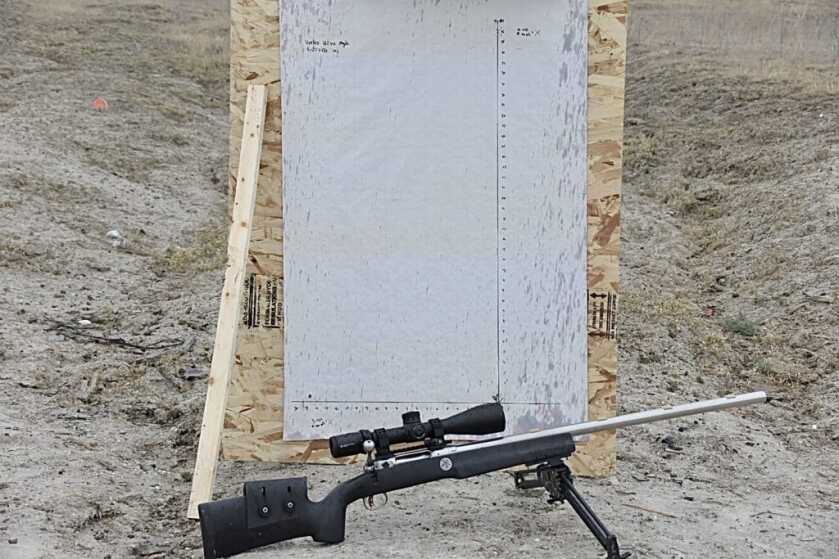
Next, I set up my shooting position about 100 yards away and then laser rangefind the distance with multiple rangefinders to confirm the range. For this purpose, I use a Leupold RX2800 TBR/W and confirm with a Leica 1600 B. I determined the distance to be 101 yards using this method. This distance will then be used later in my math to determine the tracking accuracy of the optic.
From here, I shoot. In this test, I fired 3 rounds at my point of aim at the bottom center of the target. Next, I dialed up 10 Mils exactly on the turret and fired a 3 shot group while aiming at my original point of aim, all while keeping the gun level. Immediately after, I dialed back down 10 Mils and fired a 3 shot group in a similar fashion. The distance between these two groups will be used to check the tracking accuracy of the elevation turret of the Strike Eagle. Any deviation from my vertical line will also be noted in the test.
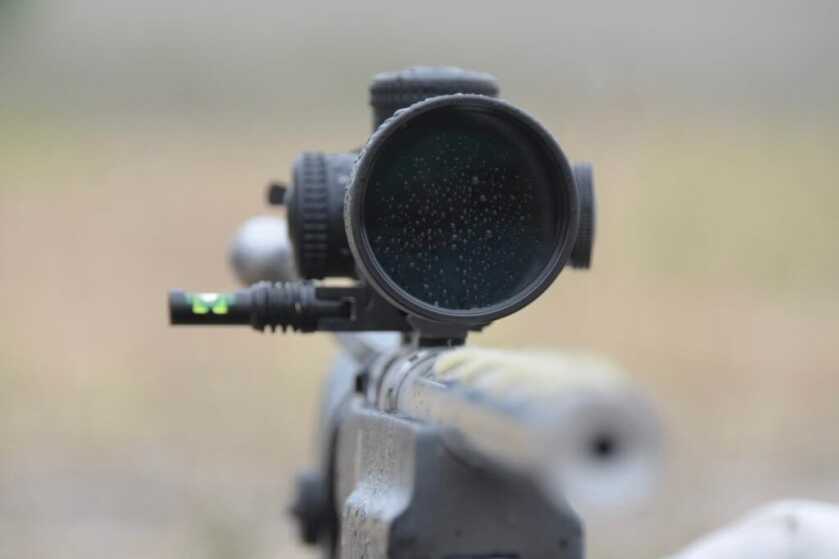
In this same string of fire, I then dialed the windage to the left 5 Mils and fired a 3 shot group. Immediately after, I dialed back to the right to meet my original zero and fired another 3 shots at the original point of aim. Again, this distance between these two groups will be used to test the tracking accuracy of the windage turret and any deviation under or above the horizontal line will be noted.
The formula I use to draw my conclusions from this test is as follows:
***Distance from target x MRAD value dialed x MRAD to inches conversion factor = expected point of impact in inches***
After measuring the distance between the reference group and test group on the X and Y axis, I found the distances to be 18.25” and 36.31” respectively. Using the equation, I found that I should expect the elevation’s distance of travel at 101 yards (confirmed with 2 different rangefinders) to be 36.36” which means that the elevation turret tracked with 99.86% accuracy in my test! Given the number of variables that I cannot control coupled with measurement precision limitations, this is outstanding performance shown by the Strike Eagle.
***101 yards x 10 mil x 0.036 inches/mil*yard = 36.36 inches***
Using the same equation, I calculated the expected distance between the reference group and test group on the X-axis to be 18.18”. Given that the experimental distance is 18.25”, this means that the windage turret tracked with 99.6% accuracy in my test. Again, another impressive result from the Strike Eagle.
***101 yards x 5 mil x 0.036 inches/mil*yard = 18.25 inches***
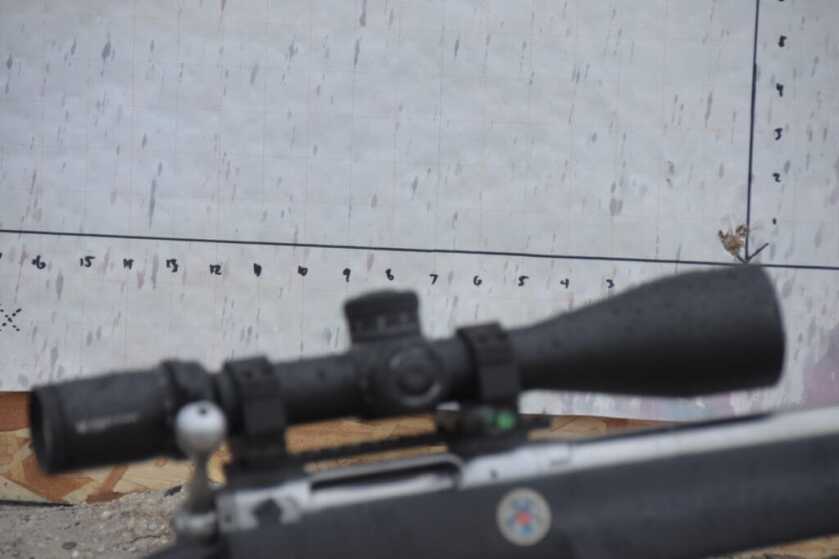
Specifications: (as listed by Vortex, MRAD model only)
- 5-25x magnification
- 56mm objective
- 3.7″ eye relief
- 24.0-5.2 ft. @ 100 yard FOV
- 34mm tube size
- locking/zero stop elevation turret
- locking windage turret
- 15 yard – infinity parallax adjustment
- 0.1 MRAD elevation adjustment
- 10 MRAD travel per rotation
- Max elevation adjustment: 31 MRAD
- Max windage adjustment: 23 MRAD
- 14.6″ total length
- 30.4 oz weight
- MSRP: $799.99
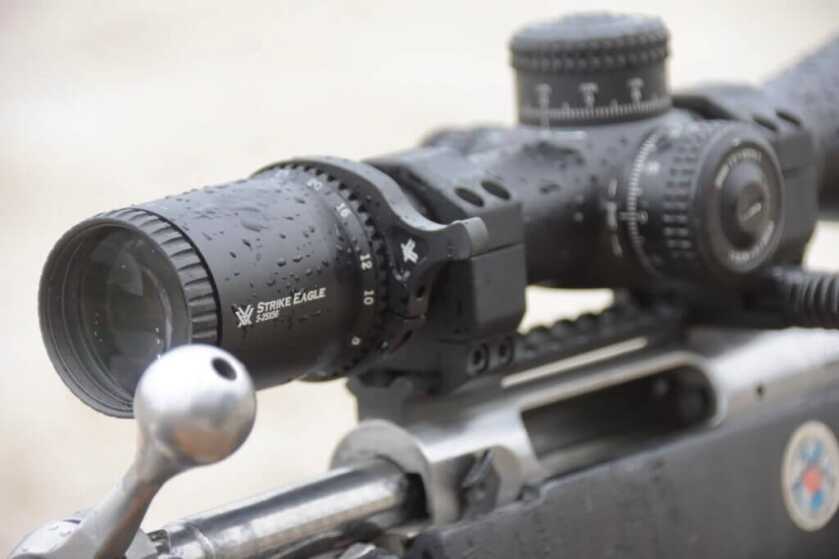
Final Thoughts
I received the MRAD model with EBR-7 (MRAD) reticle for review but now that I am done with my testing, I went and spent my own money to purchase the 5-25×56 Strike Eagle with the EBR-7 (MOA) reticle. I did this because I genuinely love the optic, but I’m a devout MOA follower.
If you are in the market for a great rifle scope that won’t break the bank, the Strike Eagle 5-25×56 is a fantastic option. For those of you who are military/LEO, even more so. Coming in well below the cringy $1,000 mark, this optic packs more features than some well established makes that cost even more than this. The key aspects that sell me on the value of this optic are its clarity and turret design, and I think that you will come to love the Strike Eagle for the same reasons.


Why can’t we have those HIGH end optics made here in the USA ?
A new scope, I wanted to know what reticles are available, are the turrets solid and dependable, is the scope clear, does it have the old style Vortex shims for the 0 stop, will it stand up to heavy recoil ? Only time will tell on the recoil issue. I thought it was an excellent evaluation, all my questions were answered. Most of my scopes cost between 1800 and 2500 so I thought it was a low price for all the options.. It never crossed my mind to argue what is a budget scope price. I just wanted to know the specks on the scope. A+ on that. Thanks
799.00 ain’t budget ,300.00 and below is budget
Where is the scope made? It’s made in communist china. If looking for it in a store, don’t forget to wear your mask.
Yes Riley, I agree with you and your awesome Guide. Vortex Strike Eagle is the best scope and it’s affortable too. I also recommend this rifle scope to everyone.
Riley has write an awesome guide. Please do not buy scope before read this guide.
Thanks Riley.
Let’s be nice the guy is just doing a review for us to read and maybe learn something from. We are all on the same side a bunch of gun loving Americans
Yeah, most of us would consider a “budget” scope to be more in the $200-$500 range. Of course there are those with lots more money to spend that might consider anything under $1000 “budget”… like the author, apparently.
“most of us” — who is “us”? shooters in general, or long range enthusiasts? if you are not interested in peak performance from a rifle, there are many optics in the 2-$500 range. Unfortunately, as anyone knows who is looking for peak performance, whether it be shooters, car enthusiasts, athletes, and more, it costs $ to push these boundries to their limit. I will not apologize naming an $800 MSRP (likely found for `$600 in store) as budget when peak performance will cost you $2,400 and up. IE: leupold mk5 HD, Zero Compromise ZC527, Vortex Razor Gen II, Nightforce ATACR, and more. On that note, I’m also not interested in an optic that will perform in a mediocre or sub-par manner. I’m not trying to sway your opinion here, only open your eyes. As a student earning my masters degree in clinical perfusion science, I’m definitely not in the category of “those with lots more money to spend”, but I know the value of buying a good optic, and this is a good optic.
Very well stated.
“NOTE: For the purpose of this article, I’m referring to sub $900 MSRP optics as “budget.””
Ah, yes! The good old “gun writer’s disconnect”.
Nothing “budget” about a $800 scope.
It is when mine cost $3,100.
I like Vortex optics too. I have several of their products. I can’t afford $800 either. I settled for a little less distance with a Primary Arms 3-18 x 50 for half the price. It’ll still get me out to 600 yards.
If you’re only looking to shoot to 600 yards, this isn’t the scope for you. And as stated, $800 is MSRP, street price is $600-$700. Max $200 price difference, and with much better features/glass quality. You also say that you have SEVERAL Vortex optics, so maybe instead of buying more optics you should take some training to shoot past 600 yards and take the gear you have out to the distances they were designed for.
Well sir, out of courtesy and respect in payment for you sharing your review, I very much enjoy using a daylight bright reticle because:
As I age and my vision continues to deteriorate:
1: The ranges I compete at often (basically always) use inexpensive (cheap garbage) paper targets printed with black ink on a very light beige or off white paper. My black reticle on a black target center are at times almost useless when trying to be ultra precise.
2: While I anyway do not need a daylight bright reticle for shooting steel, it’s sometimes very easy to “lose” my reticle while transitioning from one plate to the next especially up against a very dark (foliage covered , earth, tree lined, etc.) background, or when they “hide” a couple in the shadows.
I would almost prefer no illumination to that ugly dark red, burnt orange blob in the center of an optic while I’m trying to focus (no pun intended).
I would love to own a scope like the one in the review. But I have very limited funds for myself. I put all my family first so they don’t have to worry about anything maybe someone out there will donate a scope to a nice family man. Thank you Yuri from Idaho
Is this craig’s list?